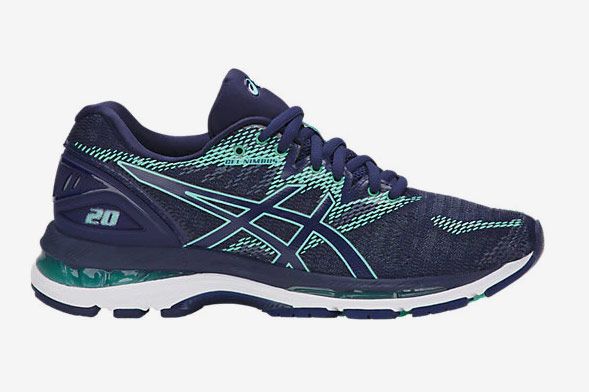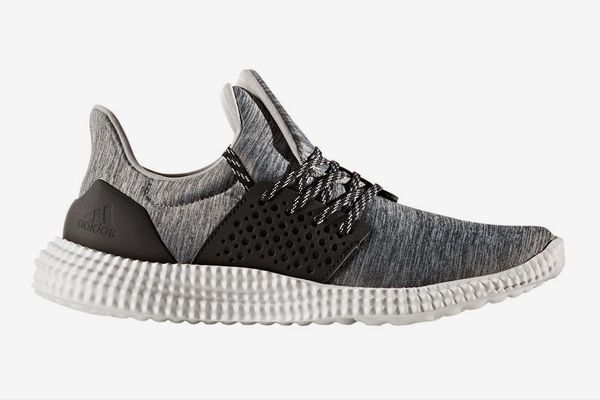
Six years ago, I made two significant and parallel career changes: I took a first full-time job as a fitness editor at Rodale Books, and I became a certified personal trainer. In between creating stories on plyometrics, or how to approach a 5K run, my job involved trying every trendy new workout out there. And that is why I can confidently tell you that no two sweat sessions are ever the same, meaning the shoes you need for certain sweat sessions are likely not the same.
That logic is how I justify owning 72 pairs of sneakers. Sneakers for quick runs. Sneakers for long runs. Sneakers for box jumps. Sneakers for dance cardio. Before this job I wore a single pair of too-small New Balance sneakers for absolutely everything — and had black toenails. But as more and more brands would send me their latest styles for editorial consideration, I started realizing how to take care of my feet and the rest of my body. I’ve tested over 200 different pairs of sneakers over the course of the last six years (I’m lucky, and have only purchased 12 pairs, give or take, myself), and now more than 70 pairs fill over-the-door shoe-shelving systems in two closets. “What sneaker should I wear for [fill in the blank workout]?” is the most popular question I get from friends. Chosen from the masses, here are the 15 favorite shoes I recommend.
Best for running a marathon
I’ve run six full marathons to date (I even did two in one week once, because I’m a masochist). This is the only sneaker I’ve ever worn for a full 26.2-mile race. At 10.7 ounces, it’s on the heavy end as far as sneaker weight goes. That’s because of the forefoot gel-cushioning system that keeps my foot comfortable mile after mile. With these, I never have to worry about uncomfortable foot cramps or pain in my arches, which is a common problem with lighter shoe options.
Best for training for a marathon
This Brooks classic uses a segmented crash pad, which is essentially an integrated system of shock absorbers, to give the runner cushioning with each step. This iteration of the Ghost, in particular, feels much bouncier than previous versions. I’ll rotate between wearing this style and the Nimbus when I get to the training stage where I’m running double-digit miles.
Best for running a half-marathon
For years, it’s been a mission of mine to find the ideal half-marathon shoe. That means one that’s both fast (translation: light) but still comfortable. In my experience, the foot doesn’t demand the same level of cushioning (which inevitably adds weight) for this distance and amount of time, which is under two hours instead of closer to the four you need for a full marathon. Nike’s latest Zoom Pegasus Turbo is the shoe I was looking for: I love the feeling of the signature FlyMesh as it hugs through the midfoot, and the grippiness of the waffle pattern on the sole gives me the control I want on pavement. They also look great, so as someone who always stresses functionality in a sneaker over pure aesthetics, it’s nice to have a shoe that actually does both.
I’ve been a diehard Dynaflyte fan since it first launched in 2016. It’s like the Nimbus, but on a diet. It has what the brand calls “Flytefoam Lite technology,” which is 55 percent lighter than industry-standard EVA foam. My feet feel supported and comfortable enough in these to go long without any unnecessary load (the shoe weighs 7.58 ounces for a women’s 7). I have a handful of runner-friends who wear this for full marathons, too.
Best for running a 5K
This sneaker has two things going for it that make it a no-brainer for quick races: a super-thin, breathable mesh upper that helps you stay cool, and a high-energy-return midsole. In layman’s terms, when a runner’s foot makes contact with the ground, the cushioning on the shoe compresses. A shoe that boasts “excellent energy return” compresses less than others. That means Reebok’s latest run-category offering, a field they’ve been really working on over the last year, delivers a pep-in-your-step feeling that helps a runner keep a quick pace.
Best for sprints
Whether you run recreationally or seriously, speedwork is something that everyone can benefit from. That’s because it helps teach muscles to tolerate the build-up of lactic acid (a byproduct of exercise that causes fatigue). This New Balance favorite feels like second skin, perfect for tackling treadmill intervals. Its bootie construction makes it feel like a custom fit and also staves off annoying blistering. And when I’m feeling especially spent, the RevLite midsole provides an extra boost right when I need it.
Best for trail running
A recreational runner may not know of Altra, but religious runners love this Utah brand. Every single one of its designs are made with a foot-shaped toe box, which lets toes relax and spread out naturally as if you aren’t wearing sneakers at all. What makes the Superior 3.5 perfect for the trail is their Duratread rubber outsole, which is grippy and durable without making the shoe super heavy.
Best for lifting weights
I’m rarely doing the type of workout where I feel like it’s important to wear a specific shoe geared toward heavy lifting. Still, that doesn’t mean I don’t have a preferred choice. The Reebok Legacy Lifter has a 3/4-inch platform that puts your foot in the ideal position for everything from squats to deadlifts. The combo of laces and Velcro straps also provides an unrivaled feeling of stability.
Best for cross-training
Walk into any CrossFit gym, and most of the people there will be wearing one of two shoes: the Reebok Nano or the Nike MetCon. That’s because they both have sturdy bottoms that can handle serious lifts. It’s also important that a sneaker made for high-intensity interval workouts has a bit of give, so that the wearer can navigate cardio movements like box jumps, burpees, and jump-rope work. The Nano 8 has all of that, and more. It also comes in more than 15 colors and can be customized.
Nike’s answer to the Nano also comes with a super stable base and durable qualities ideal for everything from rope climbs to jump lunges. I love the heel clip, which helps to stabilize the foot during lateral movement. Quick note: While it’s perfect for quick sprints and other bursts of cardio, this shoe is not for any sort of distance running. There’s nothing that makes me cringe more than seeing someone wearing these out for a casual jog.
This women’s-only style is what I go for when I’m heading to some sort of studio class that involves everything from sled pushes to squat jumps. More flexible than the other two cross-training picks (I wouldn’t necessarily lift heavy weights in this one), it’s great for the person who likes to use an elliptical, stair-climber, or other cardio machine at the gym. Bonus: It’s super flexible, which means it fits really well into an overstuffed work bag that you might be carrying around all day.
Best for a boxing class
I’m typically wary of an offset lacing style like this, but the split tongue helps get this sneaker to slide on easier. Never have I felt insecure while wearing it.
Best for a spin class
If you don’t clip in during a spin class, you’re making a major mistake. This process makes you somewhat at one with your bike, giving riders the opportunity to push and pull on the pedal with each stroke for full muscle activation (you’ll also feel more secure). But not all cycling shoes are made equal. Hesitant at first to slip on this Specialized shoe — because of the odd look of the Boa S2-SV snap dials (those circular things that replace laces) — I now can’t praise them enough. The dials help to create a really precise fit, enhanced by the bottom Velcro closure.
Best for a dance class
First, it’s important to note that these sneakers are made for running. With that said, the light and flexible knit upper and signature Boost cushioning make them ideal for all the jumping around that happens in a dance cardio class. The wider forefoot gives your foot room to expand (fact: your feet swell when you work out), which means you can go until the end of class without feeling like your feet hurt.
Best for working out when you travel
On the rare occasion that I’m packing just a small carry-on for a weekend away, these are my go-tos. Mileage-wise, they’ve got enough cushion for me to tackle any run under ten miles. They’re lightweight, fashionable, and good for everything from walking around a new city and seeing the sights to taking a random workout class.
The Strategist is designed to surface the most useful, expert recommendations for things to buy across the vast e-commerce landscape. Some of our latest conquests include the best acne treatments, rolling luggage, pillows for side sleepers, natural anxiety remedies, and bath towels. We update links when possible, but note that deals can expire and all prices are subject to change.
Every editorial product is independently selected. If you buy something through our links, New York may earn an affiliate commission.




















